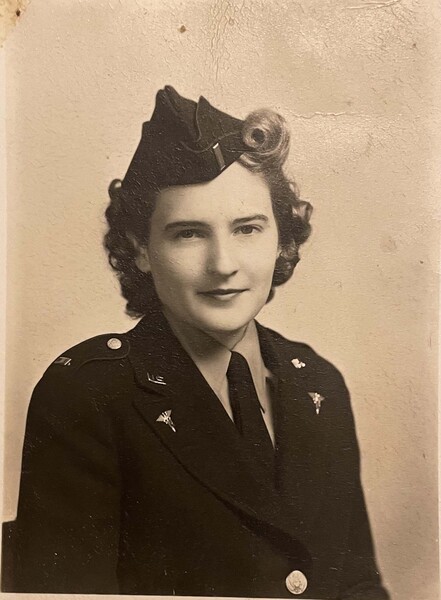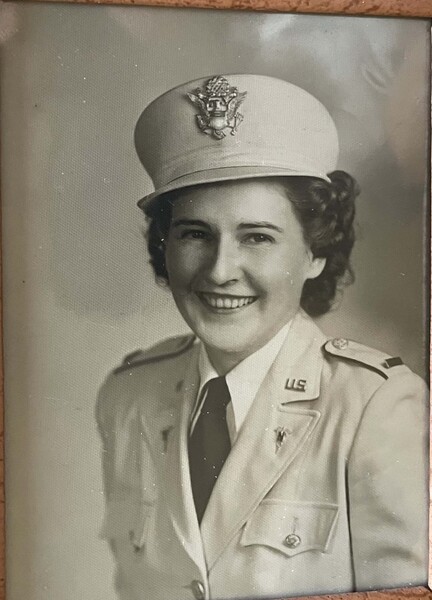Lt. Marcella (Sally) Burke Stiffler (1920-2007)
When Germany invaded Poland at the begnning of WWII, there were very few nurses or other medical personnel on active duty in the U.S. military. In 1939, many Americans believed that the United States should not become involved again in overseas conflicts. Public sentiment changed rapidly when the Japanese bombed Pearl Harbor on 7 December 1941. In response, many nurses, who were not subject to the draft because they were female, quickly volunteered for military service.
One of these nurses was Loyola University and St. Anne's Hospital School of Nursing class of 1941 graduate Marcella "Sally" Burke (later Marcella Burke Stiffler). Stiffler served in some of WWII's harshest and bloodiest battlefield conditions in England, France, Belgium, and the Philippines. Her education and war time experiences made her an excellent clinical nurse and leader in both military and civilian life. Throughout her life, Stiffler distinguished herself as a skilled nurse, compassionate caregiver for persons with disabilities, advocate for the recognition of the sacrifices of WWII veterans and women in the military, and a staunch opponent of further wars.
Sally Burke Stiffler was born on her family's farm in Iowa in 1920, one of 8 children in a large Catholic family. Her mother was a school teacher, her father a farmer. Two of her sisters also became nurses. She was the adventurer in the family and choose to leave small town Iowa, enrolling in St. Anne's Hospital School of Nursing on Chicago's West Side. She was awarded her Certificate of Graduate Nurse in 1941.
After graduation, Stiffler planned to continue traveling by becoming an airline stewardess (at that time flight attendants had to be trained nurses). Her daughter, Jan Brown, said in a 2024 interview with Dr. Diana Hackbarth that her mother "...was sitting in the outer office at United Airlines waiting for a job interview when news of the Japanese attack on Pearl Harbor was announced over the radio. She just got up and left, because a close friend lost his life on the USS Arizona that day. My mother immediately enlisted in the Army Nurse Corps."
Stiffler was sent to basic training at Fort Sheridan, Illinois, just north of Loyola's Lake Shore Campus in Rogers Park. In August 1942 she was transferred to Camp Maxley, Texas, where the U.S. Army was rapidly building an infantry base to train 350,000 men. She helped organize the base hospital, worked in the operating room, and was among the first nurses to administer the new wonder drug penicillin.
In January 1944 she married Charles Kelly, a young lieutenant assigned to a tank destroyer. Shortly after, the young couple were sent on separate assignments to England before being deployed to France where they were again stationed separately. They saw each other only once more before tragedy struck.
In August 1944, Stiffler was tending to the wounded in an evacuation hospital in France when she received word of her husband's death. According to a 10 April 2000 article in the Denver Post by Ginny McKibben, going back to work was for Stiffler the most difficult thing she ever had to do. Stiffler said that the "...Colonel called me in and told me. Then I went back to work because there was no one to take my place."
A few months later Stiffler was sent to Belgium, where the Battle of the Bulge raged during one of the coldest winters in Europe. During her last tour, she cared for people from Hitler's work camps. In the 10 April 2000 article, she told McKibben that the "...extent of man's inhumanity to man was more than I could endure. I wanted to go home."
After the war ended in the Europe, Stiffler's unit was deployed to the South Pacific by way of the Panama Canal. She served in the Philippines, eventually contracting malaria and dengue fever. She sailed to San Diego confined to a hospital bed and was discharged in December 1945 as a first Lieutenant.
The physical, psychological, and spiritual toll military service often takes on nurses and other non-combatants is now recognized as post-traumatic stress disorder (PSTD). Stiffler said in the 2000 article by McKibben that she "...didn't know what was wrong then. You felt it was all a waste somehow. The cause was still freedom. But we wondered why these things had to be settled by war, and why they had to kill all these people."
According to Jan Brown, Stiffler brought the same energy, courage, and pioneer spirit to her work and family life that she had to her military service. After she left the Army Nurse Corps, she married Charley Stiffler. Together they raised ten children. Four daughters, including Brown, became nurses. Eventually returning to nursing, Stiffler used her military experience to care for critically ill burn and transplant patients.
As is common with many veterans, Stiffler never spoke to her children about her war experiences while they were growing up. After retirement, however, she was motivated to begin sharing her story by an incident that occurred at one of her granddaughters' schools. According to granddaughter Brianne Hovey, her high school "...English and History teachers invited us to bring our grandfathers to school to tell their stories of WWII. I caught my English teacher's bias and asked 'what about our grandmothers?' To which he replied, 'Great idea, Brianne. It would be wonderful to hear about life in the US during the war.' I told him that she wouldn't be able to convey that message since she served in the Army in England, France, and the South Pacific. After that year, teachers invited her back annually. She used to come to our high school in uniform to talk about her experiences during the war. It was incredible!"
Throughout her life, Stiffler was a tireless advocate for WWII veterans, focusing especially on the need to recognize the contributions of women and nurses. She was very well read, active, and engaged into her 80's. True to her education at Loyola, she encouraged adventure, individuality, and the importance of pursuing one's unique interests as a life-long learner. She was part of a small group of WWII veterans, and the only woman in the group, to spearhead the successful effort to have a WWII memorial erected in Littleton, Colorado, in 1990. She traveled to Washington, DC, several times to visit the WWII memorial, but never glorified war. Jan Brown recalls that her mother continued to frame her WWII experiences as "man's inhumanity to man" and was dedicated to compassion and caring for others.
Marcella Burke Stiffler died in 2007. Her ribbons include: European Theater, American Theater, Asiatic-Pacific Theater, Philippine Liberation Medal, and World War II Victory Medal. She was one of the many Loyola nurses who used their professional and leadership skills to serve not only their patients but to serve our country as well.
Story by Dr. Diana Hackbarth


